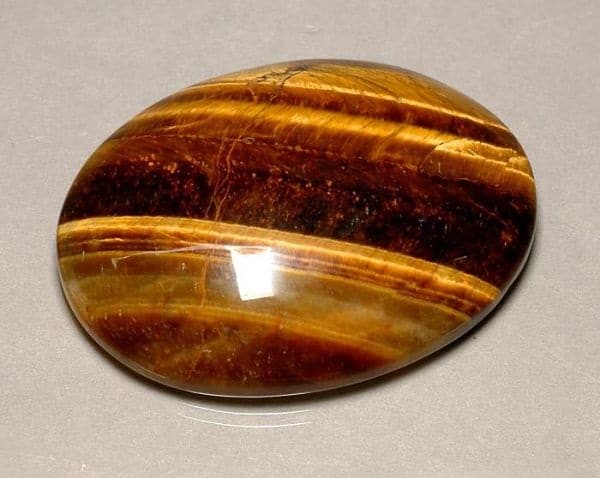
Properties and virtues of the tiger's eye
Contents:
Tiger, a powerful reddish brown with a coppery-gold look, gives this charming mineral its name. Despite its wild appearance, tiger's eye is considered protective and beneficial. A warm stone among all, the tiger's eye is credited with the ability to repel all dangers., even those at night are like bonfires lit in the past to ward off unwanted beasts.
The tiger's eye is shrouded in mystery, and its identification in the West has long been rather vague. At the beginning of the XNUMXth century, the discovery of large deposits in South Africa suddenly led to intense commercialization. It becomes very fashionable, and the craftsmen are well aware of how to bring out its beautiful golden sheen and magnificent animal colors.
Tiger eye jewelry and objects
Mineralogical characteristics
Produced from a large family of quartz, from the tectosilicate silicate group, tiger's eye is a coarse crystalline quartz. (crystals are visible to the naked eye). His face is called "fibrous". Its hardness is the same as other quartz: about 7 on a ten-point scale. Its transparency (i.e., the way light travels through the mineral) can be translucent or opaque.
The fibrous structure of the tiger's eye is explained by the presence of crocidolite filaments. (blue asbestos) turns into iron oxide and is gradually replaced by silica crystals. The decomposition of crocidolite leaves traces of iron oxide, which gives the characteristic brown-yellow tones of the tiger's eye.
Variations and related minerals

The dark red tiger's eye is called the bull's eye. This variety is most often obtained artificially by heating the tiger's eye, the colors of which change from 150 °.
Hawkeye (or eagle's eye) is a mineral very similar to the tiger's eye, but bluish or greenish in color. It is generally accepted that the hawk's eye is the result of a stage prior to the formation of the tiger's eye. Silica replaces crocidolite, but there is no change in iron oxide yet. Its color will be the same as that of the original asbestos.
Sometimes you can observe the simultaneous presence of tiger and hawk eyes in the same areas of several centimeters. Then there are the curious color waves of brown, gold, black and blue-green that are characteristic of these two species.
The mineral called oil de fer has a different origin. This is a mixture of tiger's eye with another type of quartz: jasper.
All these minerals are sometimes found in one stone: tiger's eye, hawk's eye, jasper, sometimes chalcedony. This amazing rarity, pitersite, comes from Namibia.

Provenance
Tiger's eye most often comes from South Africa, in the deposits of Griqua Town near the Kalahari. Other mining sites are mainly in the following countries: Australia, Namibia, Burma, China, India, Brazil and the USA (Arizona, California, Montana).
Iridescence (cat's eye effect)
The highly domed cabochon cut shows a special effect visible on several rare minerals: the appearance of a vertical band of light resembling a cat's pupil.
At present, the name "cat's eye" is reserved exclusively for another very valuable mineral of a different nature that clearly represents this characteristic: chrysoberyl. This does not prevent Tiger Eye from also possessing this luminous reflection, even more spectacular in dark colors, is called "iridescence".
Etymology and meaning of the name "tiger's eye"
"Eye" stones, so named in antiquity for their apparent resemblance to the eye, appear to have been plentiful in ancient Western times. Apart from the famous cat's eye, we find: goat's eye, pig's eye, snake's eye, fish's eye, wolf's eye and even a cancerous eye!
The tiger's eye does not appear in this curious bestiary. but note that these names, attributed by the European mineralogists of the past, refer to animals known to all and frequently encountered; then we see wolves in our countryside, but no tigers!
Name "tiger's eye" possibly from the eastern countriesor she imposed later for to distinguish from a cat's eye - chrysoberyl.
Tiger's eye throughout history
In the ancient world
Remarks on the origin of its name beg the question: was the tiger's eye known and used before the beginning of the XNUMXth century? Eastern and African civilizations certainly know scattered local deposits. In Europe, the Romans exploited the mines of Cornwall at Cape Lizar in England, where tiger eyes were discovered.
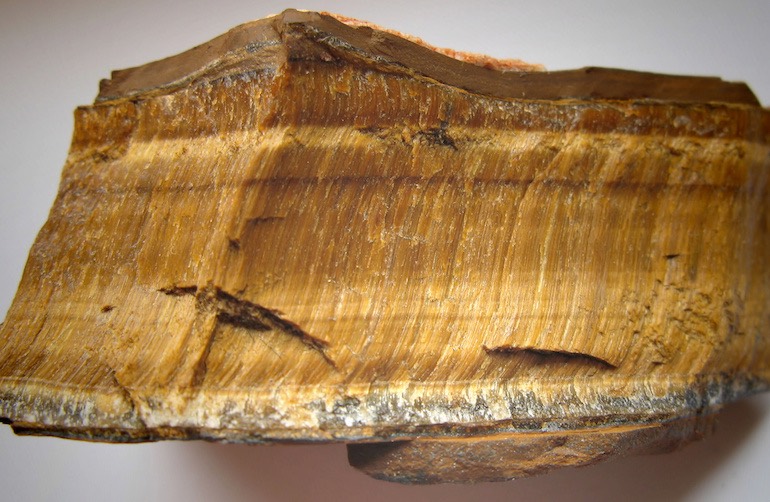
Forest " shimmering quartz are particularly fascinating, and their use in talismans and protective amulets seems likely. In antiquity, we do not find an exact description corresponding to the tiger's eye, but some comparisons are possible. provided that you do not forget the warning of Pliny the Elder: " The reader should be warned that, depending on the different number of spots and irregularities, according to different authors, and different shades of veins, the names of substances that remained the same most of the time, often changed. . »
He describes the wolf's eye (often thought to be the old tiger's eye) as follows: « The wolf's eye stone, from its Greek name: lyophthalmos, has four colors of red surrounded by a white circle, like wolf's eyes, which it completely resembles. »
Beli-oculus is even closer to the tiger's eye, Pliny did not see him, but he knows by hearsay: “Beli-oculus was whitish with a black spot in the shape of an eye and appeared golden in reflection of light. The Assyrians gave him the beautiful name of the eye of Belus and dedicated him to this God. It's also about buy (agate) resembling a lion's skin and stones are called hyenis "They say it comes from the eyes of hyenas."
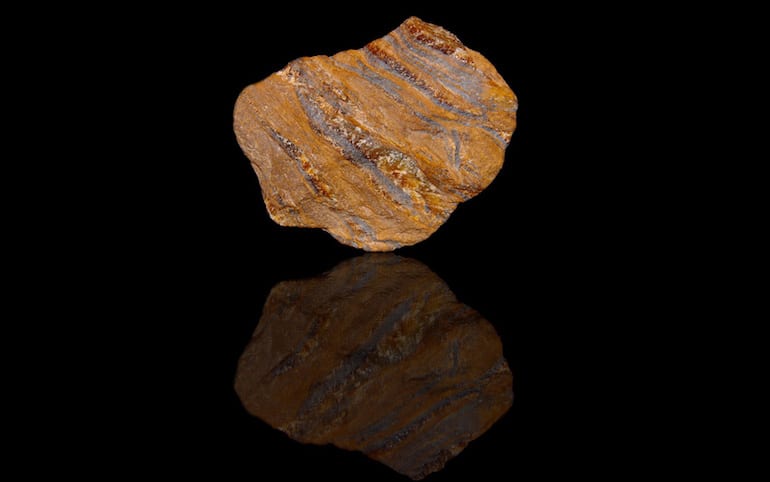
Like the eye of Ra in ancient Egypt, eye stones see everything, present and future, day and night. We find this theme in the very ancient alphabet of the Celts and Scandinavians, which became a magical divination system: debris The 23rd character or letter is called Dagaz dedicated to the balance between night and day, dawn and light. Associated stones are Sunstone and Tiger's Eye.
From the Middle Ages to the present
The fine art of stone-cutting really flourished in the XNUMXth century. Previously, laconic cutting and polishing could not fully appreciate the beauty of cat eyes. This could explain the rarity of the tiger's eye in jewelry and ancient arts and crafts.
Contemporary museums and auction houses often display tiger's eye pieces from the East or West dating back to the XNUMXth and XNUMXth centuries. Most often these are figurines, but you can also admire cups, snuff boxes, bottle caps, incense burners…
At the beginning of the XNUMXth century, we rediscovered the eye of the tiger. Coming from South Africa, it is first considered a precious stone, and then, with intensive exploitation, it is classified to a semi-precious stone. Its use is becoming more common in jewelry, ornaments and accessories. the great exotic chic at that time was a bamboo cane with a tiger's eye head!
To date, the most valuable variety of tiger's eye comes from the Mamba Marra in Australia's Pilbara region. This magnificent mineral with very bright colors is considered the king of the tiger's eye.
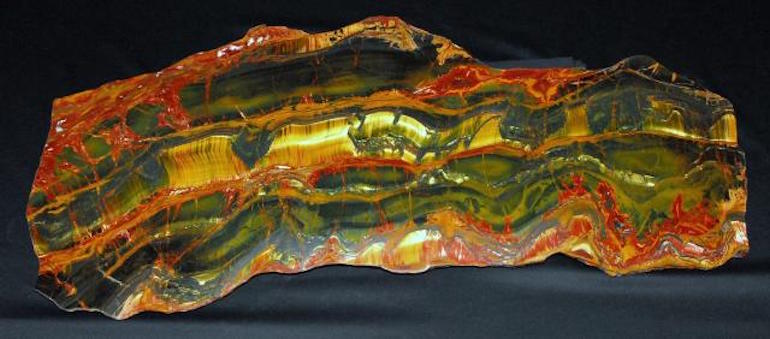
In 2005, a miner discovered the largest specimen ever found. First exhibited at the Tuescon Gems and Minerals Show in Arizona, it was then sliced. It is now admired at the front desk of a luxury hotel in Port Hedland and at the Kalgoorlie Museum, Australia's famous mining town, where it forms an impressive table top.
Advantages of a tiger's eye in lithotherapy
The tiger's eye is a protective shield Reflection of threats and dangers of all kinds. Returning negative waves to their transmitter, the tiger's eye protects against the evil eye and restores courage and energy. He erases the harmful intentions and troubles of the night, helps the mind regain clarity and calmness.
Benefits of tiger eye for physical ailments
- Relieves joint pain (osteoarthritis, rheumatism)
- Softens the knees and makes walking easier.
- Accelerates the healing of fractures
- Improves reflexes
- Promotes the practice of all sports
- Activates digestive functions, especially biliary.
- Slows down the action of bad bacteria
- Helps fight hemorrhoids
- Preserves the endocrine glands (especially the adrenal glands)
- Regulates the nervous system
- Soothes stomach pain due to stress
- Maintains visual acuity (especially at night)
Benefits of the tiger eye for the psyche and relationships
- Helps improve concentration
- Help with meditation
- dispels fears
- Restores self-confidence
- Helps overcome shyness
- Activates willpower and vitality.
- Promotes introspection (difficult memories can sometimes come up)
- Brings insight and intuition
- Stimulates a sense of observation and understanding of things
- Improves willpower and perseverance
- Remove emotional blocks
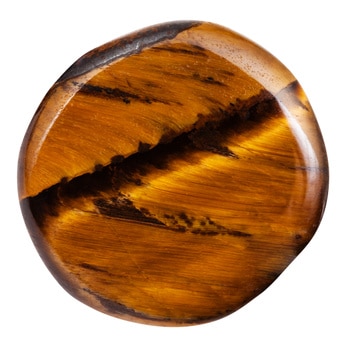
To energize the atmosphere and benefit from its protective properties under any circumstances, place a large tiger's eye stone at the entrance to your home. The smaller stone is ideal for car and other vehicles.
Let's reassure people who are worried about the composition of the tiger's eye. Potentially dangerous asbestos fibers have been completely replaced by oxides of quartz and iron, which can be handled safely. In the hawk's eye, the fibers are completely integrated into it. So there is no danger either.
Cleansing and recharging
Tiger's eye, like any quartz, should be cleaned and cleaned regularly. Avoid all chemicals. You will place your lithotherapy stone in a glass or clay container filled with distilled or salt water for at least three hours. You can also leave it under running water for 10 minutes.
Recharge will be done inside an Amethyst Geode or expose it to natural light for a few hours. : morning sun, moonbeams. Tiger's eye is sensitive to heat and acids.
Do you like tiger's eye because of its aesthetic appearance or because of the benefits it brings to you in the context of your lithotherapy practice? Feel free to share your experience by leaving a comment below!
anonym
من نخواهم بیشتر اطلاعات بگیرم در مورد چشم ببر